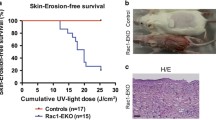Abstract
Vitamin A deficiency (VAD) is associated with increased susceptibility to carcinogenesis. CYP26A1, the gene encoding a cytochrome P450 enzyme specifically involved in metabolic inactivation of retinoic acid (RA), the most active vitamin A derivative, has been shown to result in a state of functional VAD of the cell. Recently, we demonstrated that CYP26A1 efficiently promotes cell survival properties and eventually contributes to the carcinogenic process, implying roles as an oncogene. To clarify the possible association between VAD caused by CYP26A1 expression and the development of human epithelial neoplasia, we examined whether enhanced expression of CYP26A1 might be observed in various lesions of human skin. We report here that basal keratinocytes showed only weak positivity of CYP26A1 in sunlight-nonexposed areas, whereas strong positive staining was observed in skin from chronically sunexposed body areas and in epidermis that had the dysplastic changes known as actinic keratosis. However, we found no expression of constitutive CYP26A1 in skin malignancies such as squamous cell carcinomas. Our observation suggests an involvement of enhanced CYP26A1 expression causing a functional VAD state in skin that can potentially lead to neoplastic transformation of keratinocytes in an early phase during skin carcinogenesis.
Similar content being viewed by others
References
Chambon P (1996) A decade of molecular biology of retinoic acid receptors. FASEB J 10:940–954
Petkovich M (2001) Retinoic acid metabolism. J Am Acad Dermatol 45:S136–S142
Osanai M, Petkovich M (2005) Expression of the retinoic acid metabolizing enzyme, CYP26A1, limits programmed cell death. Mol Pharmacol 67:1808–1817
Osanai M, Nishikiori N, Murata M, Chiba H, Kojima T, Sawada N (2007) Cellular retinoic acid bioavailability determines epithelial integrity: role of retinoic acid receptor alpha agonists in colitis. Mol Pharmacol 71:250–258
Osanai M, Sawada N, Lee GH (2010) Oncogenic and cell survival properties of the retinoic acid metabolizing enzyme, CYP26A1. Oncogene 29:1135–1144
White JA, Backett-Jones B, Guo YD, Dilworth FJ, Bonasoro J, Jones G, Petkovich M (1997) cDNA cloning of human retinoic acid-metabolizing enzyme (hP450RAI) identifies a novel family of cytochromes P450. J Biol Chem 272:18538–18541
Abu-Abed S, Dolle P, Metzger D, Beckett B, Chambon P, Petkovich M (2001) The retinoic acid-metabolizing enzyme, CYP26A1, is essential for normal hindbrain patterning, vertebral identity, and development of posterior structures. Genes Dev 15:226–240
Ozpolat B, Mehta K, Tari AM, Lopez-Berestein G (2002) All-transretinoic acid-induced expression and regulation of retinoic acid 4-hydroxylase (CYP26) in human promyelocytic leukemia. Am J Hematol 70:39–47
Shelton DN, Sandoval IT, Eisinger A, Chidester S, Ratnayake A, Ireland CM, Jones DA (2006) Up-regulation of CYP26A1 in adenomatous polyposis coli-deficient vertebrates via a WNT-dependent mechanism: implications for intestinal cell differentiation and colon tumor development. Cancer Res 66:7571–7577
Chang CL, Hong E, Lao-Sirieix P, Fitzgerald RC (2008) A novel role for the retinoic acid-catabolizing enzyme CYP26A1 in Barrett’s associated adenocarcinoma. Oncogene 27:2951–2960
Wolbach SB, Howe PR (1925) Tissue changes following deprivation of fat-soluble A vitamin. J Exp Med 43:753–777
Ziegler A, Jonason AS, Leffell DJ, Simon JA, Sharma HW, Kimmelman J, Remington L, Jacks T, Brash DE (1994) Sunburn and p53 in the onset of skin cancer. Nature (Lond) 372:773–776
Marks R (1995) An overview of skin cancers: incidence and causation. Cancer (Phila) 75:607–612
Wang Z, Boudjelal M, Kang S, Voorhees JJ, Fisher GJ (1999) Ultraviolet irradiation of human skin causes functional vitamin A deficiency, preventable by all-trans retinoic acid pre-treatment. Nat Med 5:418–422
Fisher GJ, Datta SC, Talwar HS, Wang ZQ, Varani J, Kang S, Voorhees JJ (1996) Molecular basis of sun-induced premature skin aging and retinoid antagonism. Nature (Lond) 379:335–339
LeBoit PE, Burg G, Weedon D, Sarasin A (2006) Pathology and genetics of skin tumours. International Agency for Research on Cancer Press, Lyon
Tobioka H, Isomura H, Kokai Y, Tokunaga Y, Yamaguchi J, Sawada N (2004) Occludin expression decreases with the progression of human endometrial carcinoma. Hum Pathol 35:159–164
Holick M (1995) Environmental factors that influence the cutaneous production of vitamin D. Am J Clin Nutr 61:638S–645S
Fornace AI (1992) Mammalian genes induced by radiation; activation of genes associated with growth control. Annu Rev Genet 26:507–526
Campbell C, Quinn AG, Angus B, Farr PM, Rees JL (1993) Wavelength specific patterns of p53 induction in human skin following exposure to UV radiation. Cancer Res 53:2697–2699
Park WS, Lee HK, Lee JY, Yoo NJ, Kim CS, Kim SH (1996) p53 mutations in solar keratosis. Hum Pathol 27:1180–1184
Loudig O, Babichuk C, White J, Abu-Abed S, Mueller C, Petkovich M (2000) Cytochrome P450RAI (CYP26) promoter: a distinct composite retinoic acid response element underlies the complex regulation of retinoic acid metabolism. Mol Endocrinol 14:1483–1497
Loudig O, Maclean GA, Dore NL, Luu L, Petkovich M (2005) Transcriptional co-operativity between distant retinoic acid response elements in regulation of Cyp26A1 inducibility. Biochem J 392(pt 1):241–248
Author information
Authors and Affiliations
Corresponding author
Rights and permissions
About this article
Cite this article
Osanai, M., Lee, GH. Enhanced expression of retinoic acid-metabolizing enzyme CYP26A1 in sunlight-damaged human skin. Med Mol Morphol 44, 200–206 (2011). https://doi.org/10.1007/s00795-010-0528-x
Received:
Accepted:
Published:
Issue Date:
DOI: https://doi.org/10.1007/s00795-010-0528-x



